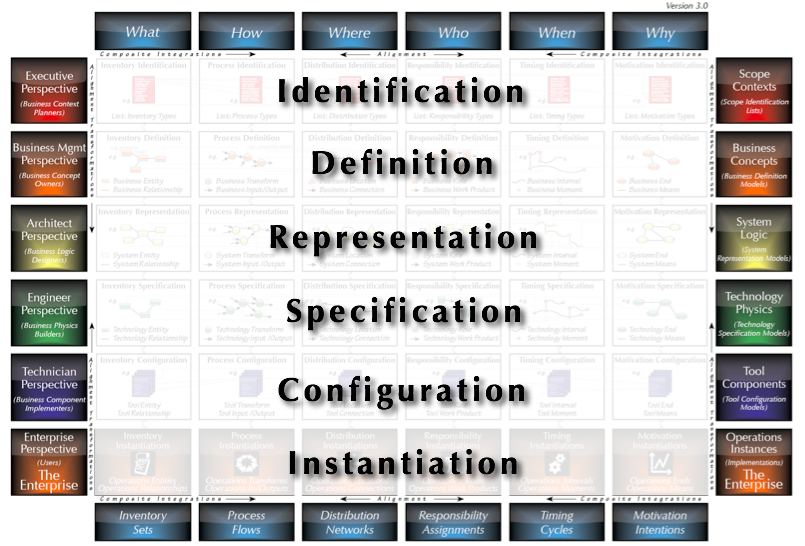Blog
Zachman International & FEAC Institute
Zachman Framework Rows. What are they?
After 30 years of talking about this, I am still shocked at the predominant misconception that the Rows of Zachman Framework define "level of detail," or "waterfall," or "decomposition." This is just not true. The Rows of the Zachman Framework define TRANSFORMATION, NOT decomposition. Level of detail is defined in the HEIGHT of each cell (or Row), NOT the height of the Framework itself. While I originally I called the Rows "Perspectives," the underlying theory that defines the Rows is the philosophical concept of Reification.
One day in Houston, I was doing a seminar for some folks and was describing the Perspectives that constitute the second dimension (the Rows) of classification depicted by my Framework and some guy in the back of the room said, "Ohhh! That's reification!" I said, "Re-if-a-what???" I never heard the word before. I said, "spell it for me" "R-e-i-f-i-c-a-t-i-o-n."
It turns out that "reification" is a word that comes out of Philosophy. The etymology of the word is from the Latin, where "RE" means "thing" so "RE - IFICATION" would mean "Thing-ifcation," making a thing, an instantiation, out of an idea that you can think about such that the thing (instantiation) bears a resemblance with the idea that you start with. Plato and Aristotle and apparently some assemblage of early Philosophers knew that an idea that you can think about is one thing but the instantiation of that idea is a totally different thing... and if you want the instantiation to bear any resemblance with the idea, the idea has to go through a well-known set of transformations.
Reification (Rows of the Zachman Framework):
- Row 1: First you have to Identify it, name it so you can have some discussion about it.
- Row 2: Next you have to Define it, the semantic intentions. The meaning, the structural definitions of the Enterprise components. The elements of Row 1 did not get more detail, they were transformed into a different perspective.
- Row 3: Then you Represent it as all engineering is done with representations, not physical material.
- Row 4: Next you Specify it based on the implementation technologies available.
- Row 5: Next you Configure it based on the tooling to be used.
- Row 6: Then, you Instantiate it- it becomes reality.
If the idea goes through this set of transformations, the Instantiation will bear resemblance with the idea. Reification is likely the more fundamental definition of the Rows of the Framework since it has been employed by humanity for several thousands of years. However, there is a strong correlation between Reification and the Perspectives as I identified them from the older disciplines of Architecture and Construction and Engineering and Manufacturing. This should not come as a great shock... there is a natural classification structure, it is manifest consistently in any application or discipline.
When you subscribe to the blog, we will send you an e-mail when there are new updates on the site so you wouldn't miss them.
Connect with us
15954 Jackson Creek Pkwy
Suite B463
Monument, CO 90132
-
dummyZACHMAN: (818) 244-3763
-
dummyFEAC: (703) 836-1002
-
dummy



Comments